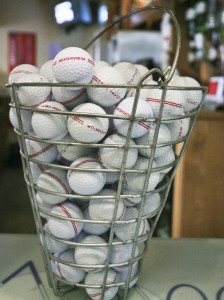Those of you who have read my first post on the subject of improving my game over winter to get to single figures (see The Dream of Single Figures: #getunder10) will have seen that one of my strategies is to measure up the distances I hit the ball with my wedges in particular. This is something everybody should do to improve. With the weather being so poor the only place to start has been the local driving range. As we all know, range balls don’t fly as far as the premium balls we tend to use on the course so this is a factor that has to be taken into account.
 But just how much distance do you lose? It seems as if there is no common agreement. I asked the question to a golf expert who told me to expect the figure to be up to 15 per cent, even with short pitches. Yet the pro at my range disagreed. He reckoned the loss would be only five per cent. The difference of opinion certainly doesn’t make it easy to accurately measure your shots. It appears that it depends on the compression of the balls used at the range. Some, where space is at a premium, buy balls made to fall way short of their real ball counterparts in order to stop them being knocked over the perimeter fence. To complicate matters further, some ranges that use these low compression balls compensate by adjusting the distance markers to give a truer impression of accurate length, but others don’t. It is a good idea to ask if the markers are accurate next time you visit, or take your own measuring device with you and check yourself. It is also very difficult to be sure of the carry and roll of your balls at the range as they tend to get muddled up with all the others.
But just how much distance do you lose? It seems as if there is no common agreement. I asked the question to a golf expert who told me to expect the figure to be up to 15 per cent, even with short pitches. Yet the pro at my range disagreed. He reckoned the loss would be only five per cent. The difference of opinion certainly doesn’t make it easy to accurately measure your shots. It appears that it depends on the compression of the balls used at the range. Some, where space is at a premium, buy balls made to fall way short of their real ball counterparts in order to stop them being knocked over the perimeter fence. To complicate matters further, some ranges that use these low compression balls compensate by adjusting the distance markers to give a truer impression of accurate length, but others don’t. It is a good idea to ask if the markers are accurate next time you visit, or take your own measuring device with you and check yourself. It is also very difficult to be sure of the carry and roll of your balls at the range as they tend to get muddled up with all the others.
To give a true assessment of the balls at my range, the pro is going to get the Flightscope out when I visit next time and we are going to test range balls against premium ones. There are other factors to take into account when trying to judge your average distances, such as wind, slope, temperature and humidity. I will be asking advice on these things and reporting back shortly.
